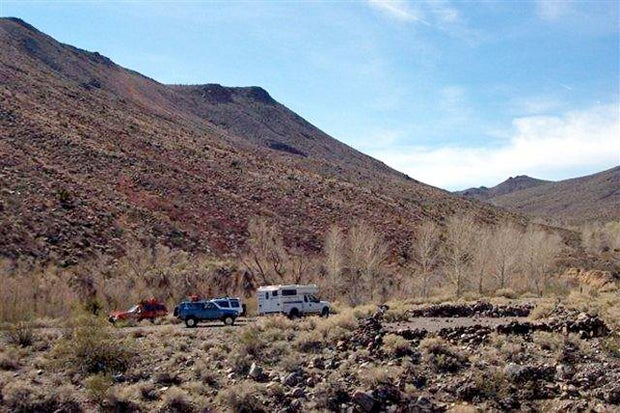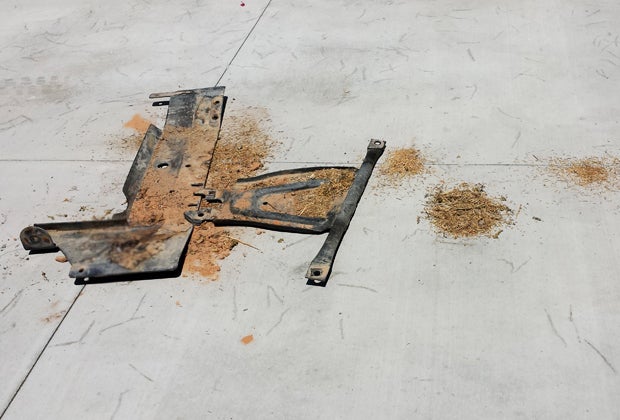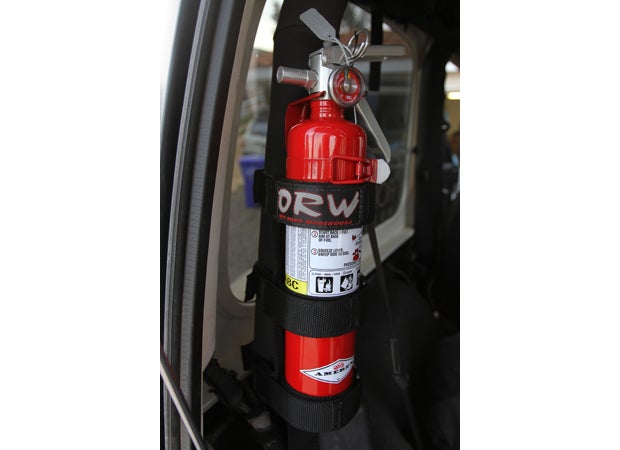
Jim and his buddy Tim were doing a pre-run on permitted but seldom-used trails in the vicinity of Tonopah, Nev. back in August. They stopped to check the map and both noticed the smell of burning grass. They did a 360 inspection and found nothing. Wildfires blazed in the Sierras, but those were too far away to be the source for this odor. They resumed their drive.
After a full day of driving, Jim stopped for another map check. He noticed smoke and flames billowing up the left side of his vehicle. Jim grabbed his 10 lb. dry chemical fire extinguisher. Lying on the ground he could see 4Ē-6Ē flames surrounding the transmission on both sides. A half dozen short blasts on each side of the transmission extinguished the flames.
A thorough inspection revealed that the area above the skid plate had become packed with dried vegetation. The front edge of his skid plate had lopped off the tops of grasses and brush as they rolled along. This vegetation, tinder dry from the hot summer, needed just a heat source to light up. (Later, Jim discovered scorched grasses in the open pocket around the plastic gas tank skid pad. Had that area ignited, he wouldíve had a really serious incident on his hands.)

Jimís experience, though uncommonly severe, serves as a good reminder of a hazard four wheelers can face. Driving through tall or heavy vegetation presents a real fire hazard. Make sure you thoroughly inspect the undercarriage whenever you stop ó whether for lunch, photo opps or a 10-100. In fact, itís not a bad idea to stop frequently if youíre driving in those conditions. It doesnít take long for the vegetation to build up.
Look inside every nook and cranny underneath. Youíll be surprised where that stuff turns up. In Jimís case, he found debris packed in the transmission cross member the next day. Donít stop inspecting until youíre positive youíre clear of any fire hazard.
A fire hazard isnít limited to drive times, either. Once at your campsite, avoid parking over tall grasses. The catalytic converter can start a fire. (Just like parking over a pile of leaves in the city.)
How to Minimize the Fire Hazards
Start with a thorough inspection and cleaning, of course. Increasing your vehicleís ground clearance helps, too. A typical vehicle offers about 10-12 inches of clearance under its skid plate. Lifting an additional 3 to 4 inches makes a big difference. ("Honey, Tom says I need to lift the vehicle for the safety of you and the kids!"). Drill large holes in the skid plate, if you have the capability. (This is what Jim eventually did with his.) Or look for a replacement model designed that way. Much of debris should fall out as youíre driving along.

Fire Extinguisher
Bigger is better and two are better than one! If and when a fire starts ó whether under the frame or under the hood ó youíll want a chance to fight it. A good fire extinguisher is a must for every 4WD vehicle. Two are even better: one up front and another in the back. Inspect those periodically to see that theyíre still charged.
While Iím on the subject of fire extinguishers, Iíd like to offer this thought. If someone walking down the street spots a fire, and a fire extinguisher on my vehicle is handy, Iíd want him to use it. Thatís what fire extinguishers are for: saving property and lives. I donít care if Iím not the one helping out. Wouldnít you be glad that a stranger grabbed the nearest tool to douse a fire involving some of your property?
Heck, I would even pay to recharge it. You get my point!
Fires, while rare, are real concerns while four wheeling. Vegetation packed in the undercarriage can go unnoticed until it builds to the point of combusting. Eliminate that hazard by thoroughly inspecting the underside of your vehicle when driving through vegetation. Also, make sure you have at least one properly rated fire extinguisher aboard at all times. These small steps can prevent disasters while off road.
MORE TRAIL TIPS STORIES
5 Tips for Concluding a Successful Off-Road Trail Ride
How to Replace U-Joints on Your 4x4
Trail Tips: What Causes Washboard Roads?
Badlands Off-Road Adventure
Off-road trainer Tom Severin shares insight and tips on a variety of topics related to preparing you for that next off-road adventure. With over 40 years of off-road experience, Severin operates under his business Badlands Off-Road Adventures. He is a certified professional 4WD Trainer by the International 4-Wheel Drive Trainers Association and a Wilderness First Responder (WFR). He is a member of the California Association of Four Wheel Drive Clubs (CA4WDC), United Four Wheel Drive Associations and the BlueRibbon Coalition. He also is a certified UFWDA and a CA4WDC 4WD instructor.
For more information about Badlands Off-Road Adventures, visit 4x4training.com.


 Your Privacy Choices
Your Privacy Choices